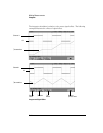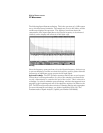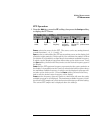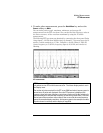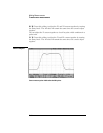
5-30
Making Measurements
FFT Measurement
FFT Measurement Hints - Continued
While the FFT spectrum is displayed, use the Math and Cursors keys to switch
between measurement functions and frequency domain controls in FFT menu.
Decreasing the effective sampling rate by selecting a slower sweep speed will
increase the low frequency resolution of the FFT display and also increase the
chance that an alias will be displayed. The resolution of the FFT is one-half of the
effective sample rate divided by the number of points in the FFT. The actual resolution
of the display will not be this fine as the shape of the window will be the actual limiting
factor in the FFTs ability to resolve two closely space frequencies. A good way to
test the ability of the FFT to resolve two closely spaced frequencies is to examine
the sidebands of an amplitude modulated sine wave. For example, at 2 MSa/s
effective sampling rate, a 1 MHz AM signal can be resolved to 2 kHz. Increasing the
effective sampling rate to 4 MSa/s increases the resolution to 5 kHz for a set 2048
point FFT.
For the best vertical accuracy on peak measurements:
• Make sure the probe attenuation is set correctly. The probe attenuation is set
from the Channel menu if the operand is a channel.
• Set the source sensitivity so that the input signal is near full screen, but not
clipped.
• Use the Flat Top window.
• Set the FFT sensitivity to a sensitive range, such as 2 dB/division.
For best frequency accuracy on peaks:
• Use the Hanning window.
• Use Cursors to place an X cursor on the frequency of interest.
• Adjust frequency span for better cursor placement.
• Return to the Cursors menu to fine tune the X cursor.
For more information on the use of window please refer to Agilent Application Note
243," The Fundamentals of Signal Analysis" Chapter III, Section 5 (Agilent part number
5952-8898.) Additional information can be obtained from "Spectrum and Network
Measurements" by Robert A. Witte, in Chapter 4 (Agilent part number 5960-5718).





